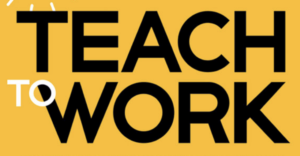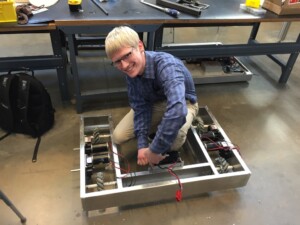Bringing Project-Based Mentors into The Educational Fold
Key Points
-
The Project Based Mentorship® model stems from Project-Based Learning theories but the difference is integrating—two different generations and culturally diverse people—around something to “do.”
-
While the mentor has vast experience in the project’s dimension and content, the mentee is the idea generator, the driver of implementation.
-
Together they share a mutual goal of master planning to a deadline and preparing an oral defense with takeaways from the project’s completion.

By: Patty Alper
I have developed and written about something I call Project Based Mentoring®. It is both new, and as old as time… What is it? What people does it help? And How?
Essentially, this idea, this methodology, is about knowledge transfer. But this is not knowledge from an educator, a theoretician, or a book – rather it is knowledge transferred from an expert in the field, a hands-on practitioner. The idea is simple: “learning from doers and learning by doing.”
Project Based Mentoring® puts a project at the center of an intergenerational relationship, where a student is the project’s leader, where the student executes to a master plan, where the student navigates real-world obstacles, and presents their findings – all while having a mentor/practitioner by their side who is experienced and from a like field.
This is a win/win for each constituent.
For a Student/Mentee, they are learning to think critically in a real-world environment. They are learning to plan and forecast, and to design actionable steps to a deadline. They are learning to collaborate and to experience the pains of their hypothesis gone awry. They are learning to present and defend their body of work to an audience of peers and professionals. Essentially, they are learning how to project-lead, but with guidance. At the end of 6 months or a year, they have a true accomplishment, a new confidence, a mentor’s endorsement, and a set of transferable skills that can be applied to a 21st-Century work environment.
Tim Kautz and James J. Heckman researched what they call non-cognitive skills, such as character, motivation, and goals – considered extremely valuable traits in the labor market. They found that the most successful non-cognitive skills are taught under mentoring environments (James Heckman and Tim Kautz, “Fostering and Measuring Skills: Interventions That Improve Character and Cognition,” National Bureau of Economic Research (2013).) Moreover, students exposed to mentorship programs have the distinct advantage of an “experiential education,” which has been shown to engender a complete learning experience for students. (Laura Joplin, “On Defining Experiential Education,” Journal of Experiential Education, 4, no. 1 (1981): 17.)
As I report under “Relevant Research” below, NFTE has performed its own studies of mentorship programs and found students exposed to a mentorship program outperformed unmentored classmates in numerous ways, including their comfort level in speaking, career-related knowledge and skills obtained, and the perception students have of the educational program.
For the Practitioner/Mentor, they are becoming an educator; they are learning to communicate simply, to manage expectations and disappointments, to share real-world experiences and be a motivator. Within the corporate world, mentorship is viewed as a form of management training, confidence building. The HR departments have also found that a positive culture shift happens when employee mentors bring this community experience back to the work environment. As well, HR is said to gain more millennial job applicants who prefer to work at a ‘do-good’ company that is not just profit-driven. Mentorship roles are known to build pipelines not only into STEM industries, but also to build a pipeline of new employees. Essentially, mentorship is creating community connections, and community educators.
Geriatric Psychiatrist Dr. Gene Cohen suggests that intergenerational support offers clear health benefits to the mentor—even if they are older or retired. An opportunity to do something with a common creative goal, and to bring together a rich diversity of perspective, makes the blended experience uniquely rich and motivating. One benefit for the mentor is a psychological reward—for being engaged and sharing your knowledge, and another is practical—in having a purpose, a schedule, and a value. “The benefits often extend far from the origin of the collaboration,” he says. (Gene Cohen, M.D., Ph.D, “The Creative Age,” William Morrow Paperbacks, 2001).
How did I arrive at this conclusion and methodology?
Through philanthropic interests, I was first introduced to NFTE, where I still sit on their national board. Back in 2001, I proposed to this nonprofit a new pilot called Adopt-a-Class. The thinking was: how can practitioners like me offer insights to youth without disrupting the classroom or the teacher? The core concept was: wouldn’t kids like hearing about my trials in building a construction company as a female entrepreneur? So, I was the first guinea pig mentor.
For 20+ years now, I have continued to mentor inner-city youth on developing business plans and taking their businesses to market. I have fostered close to 1000 students over the course of that time, working with 30-40 in a class for a full year each. I have 1000s of letters from my mentees, sharing their gratitude and their motivation to stay in business as a result of our time together. To expand the model, I wrote a 200-page plan on how to operate Adopt-a-Class, and saw the plan accelerate to 12 regions across America. I brought countless mentors to the NFTE classes in the Maryland, DC, and Virginia marketplace.
I was so excited about the impact the program had on my students and my fellow mentors that I wrote a book about it: Teach to Work: How a Mentor, A Mentee, and A Project Can Close the Skills Gap in America– expanding such that projects in all fields can be applied to this mentorship model, not just business. Others have been interested in how to bring together the corporate and academic sectors—in STEM, Cyber, Communications, Design—a host of fields.
To that end, I have written countless articles, the ideas have been covered in major news outlets, (Washington Post, NYTimes, Forbes, and Philanthropy Magazine, to name a few). I have numerous podcasts and radio interviews preaching the gospel of Project-Based-Mentorship ®. As well, I have been a consultant to post-secondary schools on developing corporate mentorship programs. And, lastly, I have been an invited speaker/author within the corporate world, the educational sector, for non-profit organizations as well as state-run education programs.
Relevant Research
NFTE wanted to know how its mentored students fared compared to classmates that were not being mentored. In an abbreviated study only within one region10 NFTE schools and 221 students were tested (Network for Teaching Entrepreneurship Survey by the Research and Evaluation Department (2014). NFTE found the following:
- The mentored students increased their self-confidence in public speaking (77% versus 63% of non-mentored students).
- The mentored students were more likely to want to own their own business (87% versus 75% non-mentored students).
- 93% of the mentored students believed they had the ability to run their own business, versus 70% of non-mentored students.
- 83% believed the things their course taught them would help them if they chose a career in business, versus 68% of non-mentored students.
- 71% gave the course high ratings, versus 46% of non-mentored students.
- 60% reported having higher class engagement, versus 45% of non-mentored students.
In another study, Dr. Susan S. Harmeling, who holds a doctorate from the Darden School at the University of Virginia, undergraduate and graduate degrees from Harvard College and Harvard Business School, has reported similar findings. Her doctoral research has shown that students who are exposed to effective mentoring can be transported to what Harmeling calls “new worlds.” (Susan Harmeling (2011) “Re-Storying an Entrepreneurial Identity: Education, Experience and Self- Narrative,” Education and Training 8/9.) The way Harmeling describes it, many students she encountered in her study of more than sixty inner-city NFTE students (from multiple states in the Northeast/mid-Atlantic corridor) are embedded in a particular, often disadvantaged reality she calls “Place A,” and although they may be exposed to “Place B” (a more desirable reality) on television or at the movies, in their minds getting to that place is unrealistic or unachievable for them. (Susan Harmeling, S Sarasvathy (2013) “When Contingency is a Resource: Educating Entrepreneurs in the Balkans, the Bronx and Beyond,” Entrepreneurship Theory and Practice 37.)
When those students are exposed to an adult mentor, however, one with a proven track record who is also accessible to them, a bridge suddenly appears between the two realities. A bridge between Place A and Place B opens possibilities. The mentor may be a success but not necessarily a star. The mentor is human, not superhuman, as he or she shares a personal trajectory incorporating struggles, missteps, dead ends, and painful disappointments. Once the students hear a real person’s life story, they can envision a new path for themselves. The story evokes the thought, “If he can do it, why can’t I?”
Why is this important in education today?
In its Great Jobs Great Lives study Gallup concluded that when six key factors are experienced by graduates during college, it doubled their odds of being engaged in their work and having a greater sense of wellbeing later in life. (Great Jobs Great Lives: The 2014 Gallup-Purdue Index Report (Washington, D.C.: Gallup, 2014), accessed February 1, 2016, https://www.luminafoundation.org/files/resources/galluppurdueindex-report-2014.pdf.) Gallup’s research, in my mind, dictates new educational priorities for better preparing youth for their future. Building on Gallup’s research and my own personal experiences and research, I’ve found that four factors can make a world of difference:
1. Incorporating the community and industry to help develop curriculum, teach educators on field-related requirements, and to integrate industry to better prepare youth for the jobs of tomorrow.
2. The critical importance of youth interfacing with adults during their school years, and in particular the importance of a Mentor – an intergenerational role model whose role is to support a student’s goals and dreams. This Mentor is to be a sounding board, a ballast, and a center for values and clarity. As well, the Mentor is a true practitioner from the real world and as such, offers real-world, practical guidelines. A Mentor plays the role of devil’s advocate and gently pushes against probabilities, all the while holding a mentee to task, and to timely completion.
3. The importance of applying what you are learning to a long-term Project. This type of learning is based not just on theory but on real-world experience. Within project development, a student starts from their own understanding of the world and a need that should be met, employing critical thinking. Next, the Mentee takes ownership in seeing that concept grow to become a reality—and successful or not, the journey is owned and in real-time. Indeed, this project becomes an accomplishment that has met a deadline, has a hard-and-fast result and is defended through a formal oral presentation. These are the skills the business world seeks.
4. An Ability to Plan. I have written extensively about Project Based Mentoring® and marrying the above three critical educational facets—industry engagement, mentorship and projects. To these, I add one of the most critical skills that is rarely taught today—the ability to plan.
I contend that the business world, the management world, the finance world, the science world, the tech world, the art world—are all project-driven. As an employee, a manager, or a leader, you are graded on your promise, your actions, your outcome, and your delivery/presentation.
Rarely in education are our students taught how to think critically, and to plan.
One of my favorite books is “Homo Prospectus,” written by Dr. Martin Seligman, the Dean of Psychology at the University of Pennsylvania. He writes, “The ability to anticipate and evaluate future possibilities for the guidance of thought and action is the cornerstone of human success.” Rather than focus on the therapies of the past, he shows how human prospection fundamentally reshapes our understandings. We are much more likely to be successful if we can anticipate and invest our time effectively and efficiently—it’s vital to how we manage in life. Two quick examples:
- He suggests that food deprivation can give a creature hunger and an urge to eat—but anticipation can intelligently regulate enabling a creature to avoid hunger in the first place.
- The same is true in competition: anticipating your competitor’s next step gives you a critical advantage.
I also believe Industry Engagement is critical because these are the employers of tomorrow. How can Educators prepare youth for an ever-changing economy if they don’t understand the newest needs of the 21st-century workforce? Industry and Academia need to align and revisit what requirements and skills are essential to succeed. Otherwise, educators are shooting in the dark, and youth will fall critically behind, be underemployed and unmotivated.
Project-Based Mentorship ® is a form of knowledge transfer. As learners take on new knowledge, there are myriad ways of inputs and outtakes. “Learning by Doing, Learning from Doers” taps into a practical, hands-on methodology. Here’s how, now you try. A mentor is not a judge, an authority, or a person that grades you—instead, the relationship mimics a respectful work relationship, a collaborator. A person with whom you can play devil’s advocate, ask questions and exchange ideas. In so many professional fields there are apprenticeships, fellowships; I’m suggesting this becomes a more broadened institutional method for learning –from true practitioners with field experience. Indeed, with 20+ years under my belt and countless student letters, I know we broaden a youth’s capacity to see themselves through a mentor’s eyes and to give them new confidence to try in the face of adversity. In other words, mentors are motivators.
Project Orientation is also critical. There is a whole school of educational best practices on Project Based Learning. It is designed to engage students in the investigation of authentic problems; it affects motivation in learning. Indeed, learning sticks when it is connected to something students understand to be important to their lives, something where they are truly invested. When others are always calling the shots and telling youth what to do, students feel powerless. But anyone willing to learn directly from reality, rather than complying with a widely accepted narrative, is in a position to innovate, critically think, expand on ideas, and be an active contributor.
As Aunt Addie Norton said in Singin’, Praisin’, Raisin’: “I tell you one thing-if you learn to do it yourself, if you have to get down and dig for it, it never leaves you. It stays there as long as you live because you had to dig it out of the mud.”
A mentor is not a judge, an authority, or a person that grades you—instead the relationship mimics a respectful work relationship, a collaborator.
Patty Alper
Research and Development – Why Corporations Participate
I have often been asked why corporations should expend the resources on mentorship programs—including programs that exist within their walls, and those that expand outwardly to the community. And in both cases, my answer is the same: because everyone, including the mentors, the mentees, and the corporation, will benefit. Employees will develop leadership skills and stronger working relationships, they will become part of something bigger, and they will grow professionally. And corporations will see more employee engagement, retention, happiness, and even increased community relations.
I can say this because over the course of my own 35-year career, as well as decades of hands-on mentoring myself, I personally witnessed the tremendous benefits. And then I started interviewing dozens of corporations and researching the value of mentorship within corporate cultures and communities, creating a mentorship program that was adopted nationally. I also spent countless hours researching and writing Teach to Work. I can attest to how careers and lives have been permanently changed, and how corporations have implemented programs only to find the positive ripple effect that touch nearly every aspect of the company’s business: profitability, employee satisfaction, corporate responsibility, hiring, and corporate image.
Project Based Mentoring Builds Character and Competency
Project Based Mentoring occurs when a mentor and mentee collaborate on a real-world project. And that collaboration lends itself to six important life lessons that embody the mentor/mentee bond.
One of the most important personality traits a mentor brings to the relationship is “if I did it – if I made it through all the struggles and bumps – you can, too.” A mentor shares the peaks and valleys in the road that she went through. And from that relationship, the mentee will also grow confidence in making it through peaks and valleys. To a mentee, the mentor is a tangible, humble, and accessible example of what success can look like. And nearly always, that success didn’t come without flaws and uncertainties. The ideal mentor illustrates that successful people learn how to persevere, and by sharing experiences with the mentee, the mentor builds the mentee’s perseverance.
Second, the ideal mentor suggests in some way, “I’m here to help you – you can count on me – AND, I’ll be back.” Mentor/mentee relationships last for months, years, and sometimes even lifetimes. I still keep in touch with mentees I first connected with over twenty years ago. When a mentee continues to come back for more mentoring, for support, and the mentor responds, the mentor communicates – without words – that people can be reliable. Some people do what they say they are going to do.
Third, a mentoring relationship gives direction. The mentor and mentee work together on projects, and the mentor provides the important perspective of experience: “here’s how I might do this – now what do you think?” This exchange offers skill development opportunities, and the courage to try. And it provides a map of what skills might need to be sharpened while completing the project.
Fourth, a mentoring relationship gives the rare opportunity to witness a healthy, give-and-take dialogue. When troubleshooting a project, the ideal mentor will ask difficult or provoking questions, or simply play devil’s advocate. Mentors may even probe whether a mentee has thought through certain scenarios. What the mentee learns is that workplace dialogues can have a back-and-forth, compromise, and even redirection, all while being respectful. This provides important feedback on how to interact in an office setting without alienating or harshly criticizing others.
The fifth aspect a mentor relationship offers is gentle accountability. A mentor is willing to stand in the role not as a mentee’s judge, and not as a boss. Instead, the mentor should be more like a consultant, a non-judgmental listener. The mentee should feel a slight accountablity – and his consultant, his mentor, wants to see him succeed.
Finally, an ideal mentor wants to hear what the mentee has to say. The mentor volunteers her time and resources to the relationship and through simply listening, makes the mentee feel heard. This simple act builds communications skills and confidence. It allows the mentee to be the leader in respectful intergenerational dialogue.
In summary, I have witnessed the magic that can happen when educators invite Project Based Mentorship® into their classroom. It can be transformative for the mentor and mentee, and it provides countless benefits for the educator and the corporation and the community where they reside together.
Patty Alper is president of the Alper Portfolio Group, a marketing and consulting company, and is a board member of both the Network for Teaching Entrepreneurship (NFTE) and US2020, the White House initiative to build mentorship in STEM (science, technology, engineering, and math) careers.







Lily Bridgers
My cousin, who recently experienced a significant life transition, such as a relocation or change in family dynamics, is facing difficulties in adapting and finding their place in their new environment. Recognizing the need for guidance, mentorship, and a positive support system, they are actively seeking a youth mentoring program to help them navigate through this transitional period and build resilience and confidence in their new surroundings. I think it'll help her to know that a bridge between the two realities arises when those youngsters are exposed to an experienced adult mentor who is also approachable to them. https://iamhouston.info/